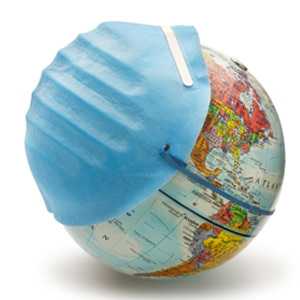
The World Health Organisation (WHO) do this with the help of four WHO Influenza Collaborating Centres for Virus Reference and Research in:
- Atlanta, Georgia, USA,
- London, UK
- Melbourne, Australia and
- The WHO Collaborating Centre for Influenza Epidemiology in Tokyo, Japan.
The worldwide surveillance network includes the following:
- 110 National Influenza Centres, including the National Institute of Virology (NIV) in South Africa, in 83 countries. (Virology laboratories across the country report their findings weekly to the NIV in Gauteng, and the NIV is in charge of a national weekly surveillance of the South African situation).
- These laboratories send flu viruses recovered from patients to one of the four WHO Influenza Collaborating Centers for further testing.
- Results from the network are reviewed each February and September in Geneva, Switzerland.
- Based on this up-to-date collection, the WHO make recommendations about which strains of influenza viruses are likely to circulate in the coming year.
- The WHO gives vaccine manufacturers the "seed stock" of the viruses that should be used to produce the next vaccine. Since 1977 there have been two strains of influenza A circulating around the world (an A-H1N1 and an A-H3N2), along with the single influenza B strain. Therefore there are three viruses in the flu vaccine.
- To increase the accuracy of flu vaccines, there are now separate vaccines made every six months for the winter seasons of the Northern and Southern hemispheres.
- The vaccine is composed of the current strains of flu that are grown in chick embryos or cell cultures and then chemically inactivated. The WHO stimulates vaccine research on tissue culture and other methodologies for vaccine production to reduce the dependence on fertilised eggs. The dependence on fertilised eggs poses a constraint to vaccine production as the stock is limited. The WHO also asks pharmaceutical manufacturers to speed up production if large amounts of vaccine are necessary.
- At present the WHO does not recommend the production of a specific H5N1 vaccine. A very potent avian H5N1 killed six people in Hong Kong in 1997, and raised fears of a new killer flu virus. Luckily none of the genes of the avian virus were incorporated into the current human influenza A viruses and antigenic shift did not take place.
- The four WHO Collaborating Centres are currently working on various strains to prepare high growth assortants which could be used for vaccine production in case of need. This work is complicated by the fact that the original H5N1 avian virus isolated in Hong Kong also kills fertilised eggs used for vaccine production. The preparation of an H5N1-vaccine or any completely new vaccine strain would take several months after the selection of a suitable virus strain. Work with the live H5N1 virus is restricted to laboratories adhering to very specific safety precautions.
- Live vaccines (in spray or droplet form) and DNA vaccines are alternatives that might be used in future.
- First generation (1958) whole virus vaccines produced a satisfactory immune response but with a higher risk of side-effects. Second generation (1968) "split" vaccines contain the fragmented and purified particles from the virus, including the two surface proteins and the other viral constituents. Third generation "subunit" vaccines (eg Influvac, Vaxigrip) contain only the surface antigens (hemagluttinin and neuraminidase) and are devoid of other viral constituents thus reducing the protein load in the vaccine. Split and subunit vaccines have less side-effects and are recommended for children since they have reduced side effects.
Pandemic planning by the WHO
The WHO created a Task Force of Experts on Influenza in 1999. The task force includes the directors of the four WHO collaborating centers, WHO staff, and representatives from three of the 110 national influenza centers.
The task force has developed a draft plan for the Global Management and Control of an Influenza Pandemic.
The plan includes:
- surveillance for and identification of pandemic viruses,
- dissemination of information,
- logistic and other support to national health authorities,
- the promotion of high growth seed virus for vaccine, and
- the facilitation of vaccine production and international distribution.
The plan calls for each national health authority to develop its own pandemic emergency response plan.
American and British virologists and epidemiologists are very concerned about the probability of a new killer influenza virus emerging soon.
Countries must gear themselves for the next flu pandemic, American researchers warned at an international scientific conference in London.
Analysis of the natural mathematical cycles of flu pandemics and epidemics, antigenics drifts and shifts, show that a major antigenic shift is long overdue. It is only a matter of time before the next flu pandemic will hit the globe, Dr Martin Meltzer of the Centres for Disease Control and Prevention (CDC) in Atlanta, Georgia said at the Second International Retroscreen Science Conference.
Doctors and governments must plan for the next pandemic: they must make sure that they have access to enough flu vaccine and antiviral flu medication.
According to American epidemiologists the full global production of flu vaccine might not be sufficient to prevent a pandemic. Some researchers are of the opinion that the new antiviral drugs (neuraminidase-inhibitors) would be more effective curbing an pandemic than flu vaccines.




 Publications
Publications
 Partners
Partners















